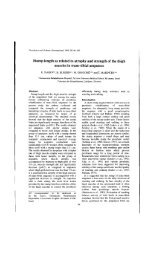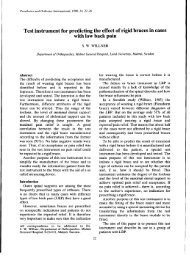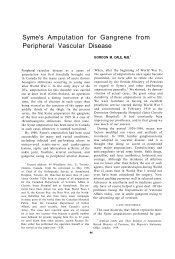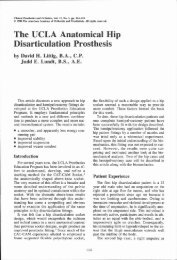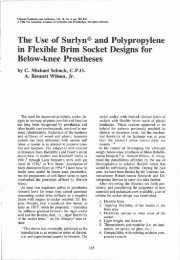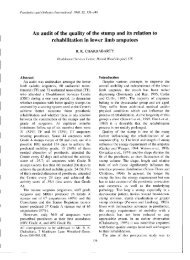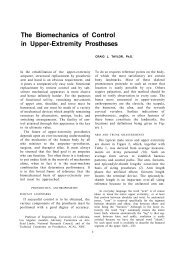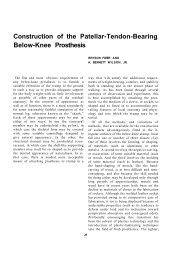Pro-Corn - O&P Library
Pro-Corn - O&P Library
Pro-Corn - O&P Library
You also want an ePaper? Increase the reach of your titles
YUMPU automatically turns print PDFs into web optimized ePapers that Google loves.
Orthotic Management of the<br />
Arthritic Foot<br />
by C. Michael Schlich, C.P.O.<br />
With ever increasing public exposure, orthotists<br />
are being requested more frequently to<br />
confront new challenges caused by physical<br />
disability. In the spectrum of orthotic protocols,<br />
management of the arthritic foot and<br />
ankle is a relatively new challenge. During the<br />
past five years, the Department of Orthopaedics<br />
and Rehabilitation, the Division of Rheumatology,<br />
and the Division of <strong>Pro</strong>sthetics and Orthotics,<br />
all of the University of Virginia Medical<br />
Center, have comprised an Arthritis Rehabilitation<br />
Research and Training Center,<br />
providing a regional referral center for arthritis<br />
patients. Orthotic services for these patients<br />
have concentrated on the foot and the ankle,<br />
and this population of patients has been substantial<br />
enough to permit the development of a<br />
consistently successful protocol of management.<br />
The intent of this paper is to review the<br />
skeletal anatomy of the ankle and foot, discuss<br />
the types of arthritis and their relative pathophysiology<br />
and clinical manifestations, and finally<br />
to present our protocol for management of<br />
the various problems presented by the arthritic<br />
foot and ankle.<br />
Review of Ankle-Foot Anatomy<br />
The skeleton of the foot consists of three<br />
groups of bones: tarsal bones, metatarsal<br />
bones, and phalanges. The tarsal bones are further<br />
divided into two groups, the first group<br />
consisting of the talus and the calcaneus, together<br />
forming the hindfoot. The talus, which<br />
is the only bone to articulate with the tibia and<br />
the fibula, acts as a rocker by which the foot as<br />
a unit can be dorsiflexed and plantarflexed at<br />
the hinge of the ankle joint. In stance, the talus<br />
receives the entire weight of the lower limb;<br />
half this weight is transmitted forward to the<br />
bones forming the arch of the foot, and half of<br />
the weight is transmitted downward to the heel<br />
or calcaneous. The calcaneus, or os calcis, is<br />
the bone of the heel. It supports the talus, withstands<br />
shock as the heel strikes the ground, and<br />
transfers forward the portion of body weight it<br />
receives from the talus.<br />
The second group of tarsals consists of the<br />
five bones anterior to the talus and the calcaneus.<br />
The navicular, cuboid, and three cuneiforms<br />
increase flexibility of the foot, particularly<br />
in its twisting movements. These bones<br />
form the longitudinal arch of the foot, and are<br />
referred to collectively as the midfoot.<br />
The five metatarsal bones lie anterior to and<br />
articulate with the second group of tarsal bones<br />
described above. Each metatarsal consists of a<br />
base, a shaft, and a head, in respective order<br />
from proximal to distal. The distal-most bones<br />
of the foot are the five phalanges, which extend<br />
from the five metatarsals and form the bones of<br />
the toes. The metatarsals and the phalanges<br />
form the forefoot.<br />
The foot has three arches: the medial, lateral,<br />
and transverse. The normal medial arch rises<br />
through the calcaneous to the head of the talus,<br />
and from this high point it descends forward<br />
through the navicular, cuneiforms, and first<br />
three metatarsal heads. The lateral arch, which<br />
is lower than the medial, extends from the cal-



